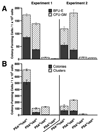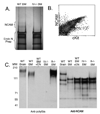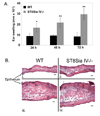Polysialic acid, a glycan with highly restricted expression, is found on human and murine leukocytes and modulates immune responses
- PMID: 18981104
- PMCID: PMC2718713
- DOI: 10.4049/jimmunol.181.10.6850
Polysialic acid, a glycan with highly restricted expression, is found on human and murine leukocytes and modulates immune responses
Abstract
Polysialic acid (polySia) is a large glycan with restricted expression, typically found attached to the protein scaffold neural cell adhesion molecule (NCAM). PolySia is best known for its proposed role in modulating neuronal development. Its presence and potential functions outside the nervous systems are essentially unexplored. Herein we show the expression of polySia on hematopoietic progenitor cells, and demonstrate a role for this glycan in immune response using both acute inflammatory and tumor models. Specifically, we found that human NK cells modulate expression of NCAM and the degree of polymerization of its polySia glycans according to activation state. This contrasts with the mouse, where polySia and NCAM expression are restricted to multipotent hematopoietic progenitors and cells developing along a myeloid lineage. Sialyltransferase 8Sia IV(-/-) mice, which lacked polySia expression in the immune compartment, demonstrated an increased contact hypersensitivity response and decreased control of tumor growth as compared with wild-type animals. This is the first demonstration of polySia expression and regulation on myeloid cells, and the results in animal models suggest a role for polySia in immune regulation.
Figures










References
-
- Inoue S, Inoue Y. Developmental profile of neural cell adhesion molecule glycoforms with a varying degree of polymerization of polysialic acid chains. J Biol Chem. 2001;276:31863–31870. - PubMed
-
- Nakata D, Troy FA., 2nd Degree of polymerization (DP) of polysialic acid (polySia) on neural cell adhesion molecules (N-CAMS): development and application of a new strategy to accurately determine the DP of polySia chains on N-CAMS. J Biol Chem. 2005;280:38305–38316. - PubMed
-
- Varki A, Cummings R, Esko J, Freeze H, Hart G, Marth J. Essentials of Glycobiology. Cold Spring Harbor, NY: Cold Spring Harbor Laboratory Press; 1999. - PubMed
-
- Curreli S, Arany Z, Gerardy-Schahn R, Mann D, Stamatos NM. Polysialylated neuropilin-2 is expressed on the surface of human dendritic cells and modulates dendritic cell-T lymphocyte interactions. J Biol Chem. 2007;282:30346–30356. - PubMed
-
- von Der Ohe M, Wheeler SF, Wuhrer M, Harvey DJ, Liedtke S, Muhlenhoff M, Gerardy-Schahn R, Geyer H, Dwek RA, Geyer R, Wing DR, Schachner M. Localization and characterization of polysialic acid-containing N-linked glycans from bovine NCAM. Glycobiology. 2002;12:47–63. - PubMed
Publication types
MeSH terms
Substances
Grants and funding
LinkOut - more resources
Full Text Sources
Other Literature Sources
Medical
Molecular Biology Databases
Research Materials
Miscellaneous

